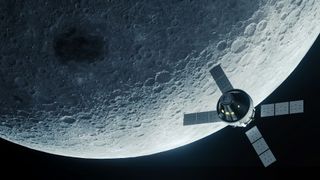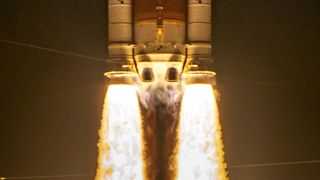
Why is it so hard to send humans back to the moon?
The Apollo program put humans on the moon in 1969. So why haven't we sent any more since?


Between 1969 and 1972, the Apollo missions sent a total of a dozen astronauts to the surface of the moon — and that was before the explosion of modern technology. So why does it seem like our current efforts, as embodied by NASA's Artemis program, are so slow, halting and complex?
There isn't one easy answer, but it comes down to money, politics and priorities.
Let's start with the money. Yes, the Apollo missions were enormously successful — and enormously expensive. At its peak, NASA was consuming around 5% of the entire federal budget, and more than half of that was devoted to the Apollo program. Accounting for inflation, the entire Apollo program would cost over $260 billion in today's dollars. If you include project Gemini and the robotic lunar program, which were necessary precursors to Apollo, that figure reaches over $280 billion.
Related: Astronauts won't walk on the moon until 2026 after NASA delays next 2 Artemis missions
In comparison, today NASA commands less than half a percent of the total federal budget, with a much broader range of priorities and directives. Over the past decade, NASA has spent roughly $90 billion on the Artemis program. Naturally, with less money going to a new moon landing, we're likely to make slower progress, even with advancements in technology.
Closely tied to the financial realities are the political realities. In the 1960s, America was in the midst of the space race, a competition with the Soviet Union to achieve as many firsts in space, especially landing humans on the moon. The public was on board and energized by this idea, as were lawmakers who directed NASA's expansive budget.
That kind of spending, however, was deeply unsustainable. As soon as America "won," the public quickly lost interest and NASA funding tumbled. There simply isn't the political or public will to spend that amount of money for a second shot at the moon.
Get the Space.com Newsletter
Breaking space news, the latest updates on rocket launches, skywatching events and more!
This combination of lower political will and fewer financial resources forced NASA to make some critical decisions in the late 1990s and early 2000s — decisions that still affect Artemis today.

Namely, as the space shuttle program was winding down, NASA administrators didn't know what to do with the industrial capabilities and partnerships that led to the shuttle. They decided to keep that infrastructure in place by reusing many shuttle parts, especially the engines, and folding them into the Artemis design.
On the other hand, one could argue that it was the right call to keep that infrastructure in place and aerospace engineers employed, because it was exactly that technical base that we needed to launch the recent renaissance in private spaceflight companies — but that's a separate discussion.
Lastly, the modern Artemis concept has a much different set of priorities than the Apollo missions did. For example, our risk tolerance is much, much lower than it was in the 1960s. The Apollo missions were outright dangerous, with a significant chance of failure. Indeed, several missions did encounter disasters: the Apollo 1 fire that killed three astronauts, an engine shutdown during Apollo 6, and the near-fatal design flaw that nearly led to the deaths of the Apollo 13 astronauts. NASA, lawmakers and the public are not willing to take on that level of risk again, especially after the Challenger and Columbia disasters.
The Apollo missions expended enormous sums of money to send astronauts to the lunar surface for a few dozen hours. They went, collected some samples, set up some simple experiments, and left.
The Artemis missions are designed around a completely different set of goals. For one, the astronauts will spend up to a week on the lunar surface, which requires more food, water, fuel and scientific instruments. Second, while the Apollo missions treated science as an afterthought — the main goal was to beat the Soviets — scientific investigation will take center stage in the Artemis program, meaning it entails a longer, more complex mission design.
Lastly, the intent of the Artemis program isn't just to return humans to the moon; it's to begin building the infrastructure to maintain a permanent human presence there. Everything from orbiting refueling depots to site selection for future colonies falls under the umbrella of the Artemis project. It is a much more involved program because it provides the framework for achieving dreams for generations to come.
Join our Space Forums to keep talking space on the latest missions, night sky and more! And if you have a news tip, correction or comment, let us know at: community@space.com.

Paul M. Sutter is an astrophysicist at SUNY Stony Brook and the Flatiron Institute in New York City. Paul received his PhD in Physics from the University of Illinois at Urbana-Champaign in 2011, and spent three years at the Paris Institute of Astrophysics, followed by a research fellowship in Trieste, Italy, His research focuses on many diverse topics, from the emptiest regions of the universe to the earliest moments of the Big Bang to the hunt for the first stars. As an "Agent to the Stars," Paul has passionately engaged the public in science outreach for several years. He is the host of the popular "Ask a Spaceman!" podcast, author of "Your Place in the Universe" and "How to Die in Space" and he frequently appears on TV — including on The Weather Channel, for which he serves as Official Space Specialist.
-
orsobubu I always have big doubts when I read these statistics regarding the costs compared in different eras; john williams, for example, calculates that today inflation in america, using the same mathematical method (which has nothing to do with the obviously different basket of goods) used until 1980, is quadruple the official one, and that over the course of the years, at least since 2000, has been on average about 8 points higher than that declared.Reply -
Redderek I've heard that the technology of the SaturnV was destroyed once the Apollo program was closed. This was to keep the Soviets from obtaining any knowledge for their own gain. Thus, we essentially destroyed the technology to go back.Reply -
billslugg All Apollo learnings are, and always have been, public. Subscribe to NASA Technical Briefs for all the details.Reply -
DaGuyDaGuy Reply
The answer is much simpler. The Apollo program was flown by astronaut pilots, many of them test pilots with combat experience who were accustomed to operating in hostile environments with few creature comforts. Who today would be willing to sit in a an Apollo capsule in a webbed seat for a week, in a spacecraft controlled by a computer less powerful than your TV remote control? Now we have layer upon layer of 'human engineering' focused on creature comforts. A trip to the moon is no longer a mission designed for military pilots, but an adventure that any Tom, Dick or Sally can 'experience'. Von Braun was correct in that it is orders of magnitude less efficient and more expensive to send humans into space than instruments. And with humans come creature comforts and the specter of liability and lawsuits if anything goes wrong. Or is uncomfortable. Or not 'all inclusive'. The math is simple: people in space = $$$$$$$$$$$$$$$$$$$$, lawyers, politics and bureaucrats.Admin said:The Apollo program put humans on the moon in 1969. So why haven't we sent any more since?
Why is it so hard to send humans back to the moon? : Read more -
billslugg There is no reason to send humans to the Moon. There is nothing to do there that bots can't handle. The only reason we did it in 1969 was to prove to the world we were better than the Soviets. That need has passed. We don't care about China's Moon aspirations. Have at it, we will have fun watching. Best of luck to you.Reply -
Unclear Engineer Reply
Bill, astronauts managed soft landings on the Moon 6 times out of 6 tries. Bots are less than 50% if I remember the numbers correctly.billslugg said:There is no reason to send humans to the Moon. There is nothing to do there that bots can't handle. The only reason we did it in 1969 was to prove to the world we were better than the Soviets. That need has passed. We don't care about China's Moon aspirations. Have at it, we will have fun watching. Best of luck to you.
As for "needs", that depends on your perspectives about learning new things. If we don't need to learn new things, we could just stop exploring. But, if we do want to learn new things, humans are much better at recognizing them than any robots we can build today. Using bots is like looking at something through a knothole that is in a fixed position - hard to really understand the big picture. -
motie The propulsion challenge is stupendous. See the link below. I am not convinced that this is ever going to happen. https://www.americaspace.com/2024/04/20/starship-faces-performance-shortfall-for-lunar-missions/Reply -
motie Reply
Robotics and AI are already frightfully advanced. A robotic explorer can already have vision and chemical analysis capabilities that are vastly greater than a human's. Also, the communication delay between Earth and Moon is only one second. So real-time remote control and communication is easy. But the biggest advantage by far may be that there is no risk of loss of human life. Let's be honest here. Americans of the 2020s are not like Americans of the 1960s. Our space program may not recover from the loss of a crew, very likely in very painful circumstances. Also, it is the physical needs of humans that make the payload so heavy. See the article which I linked above. The fuel requirement for one manned mission is absolutely ridiculous. This is what I predict: the US military will find some justification for a base on the Moon. They will do the whole thing robotically. To quote Doughas Adams, "This may have already happened." The money will come from the "infinite" defense budget. Robotic construction can be guided by humans on Earth. This is very different from the situation on Mars, where there is a ten-minute communication delay. Maybe in the future, somebody will find a way to transfer human consciousness to an indestructible mechanism. Call it a cyborg. Then it will be practical for human consciousness to travel off the planet without carrying a boatload of life support junk with us.Unclear Engineer said:Bill, astronauts managed soft landings on the Moon 6 times out of 6 tries. Bots are less than 50% if I remember the numbers correctly.
As for "needs", that depends on your perspectives about learning new things. If we don't need to learn new things, we could just stop exploring. But, if we do want to learn new things, humans are much better at recognizing them than any robots we can build today. Using bots is like looking at something through a knothole that is in a fixed position - hard to really understand the big picture. -
Unclear Engineer My reading of the news about the robotic missions to both the Moon and Mars is that they have very limited capabilities, compared to humans. Sure, that will improve. But, it really has a long way to go. We don't even have reliable self driving cars, and that is in an extremely well know environment.Reply
We will eventually see how Musk makes out with the Moon missions. NASA was already supposed to be there, now, but could not get the funding - so they just kept slipping the schedule. Musk is just going as fast as the FAA will allow, but he doesn't really have to make a particular schedule for his own programs.
If NASA wants somebody to blame for schedule slips, they will probably use SpaceX as the scapegoat, but it is really Congress that has slowed the pace of SLS. NASA should have been designing the lander as soon as they started designing the launch vehicle, since the payloads govern the launch requirements. -
Unclear Engineer AI can become really good at performing really well defined tasks, if it is programmed well enough. But, it has been a total bust at performing critical thinking.Reply
